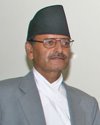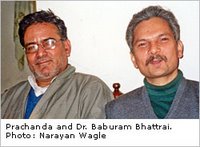
BY BIKASH SANGRAULA , The Kathmandu Post
KATHMANDU, Oct 8 - Nepal-India cooperation in water resources has remained an emotive issue for this northern neighbor for over six decades, and not without reason. Under unequal treaties - especially the 1920 Sarada agreement, 1954 Koshi agreement and 1959 Gandak agreement - signed with the southern neighbor, Nepal gained little while losing control over much of its water.
These treaties spawned lasting suspicion among the Nepalese. The suspicion feuls tumultuous manifestations whenever there is talk of possible new agreements with India on water resources. The degree of suspicion is so high that major agreements such as the Mahakali package - that includes the 6,480 MW Pancheswar project, Tanakpur and the Sarada barrage - ratified by a two-third majority of parliament in 1996, has not made any headway. Similarly, the 10,800 MW Karnali-Chisapani Project is also stuck with the two sides unable to agree on compensation for regulated water.
Entry of Indian private sector
Suspicions notwithstanding, Nepali authorities are currently reviewing proposals submitted recently by several Indian private sector companies for conducting feasibility studies on sizeable projects including the 600 MW Budhi Gandaki, 402 MW Arun-III and 300 MW Upper Karnali. This is the first time India's private sector has shown interest in hydropower generation in Nepal. This development was triggered partly by the Electricity Act of India 2003 that opened the Indian power market to all, and partly by the growing demand for power in India to meet its growth aspiration of eight percent per annum. India ranks sixth in the world in total energy consumption, and is a net importer of energy, with 25 percent of primary energy demands being met through imports.
Seeing a lot of interest among India's private sector, Nepali authorities are upbeat to the extent that Minister of State for Water Resources Gyanendra Bahadur Karki termed it "an opportunity that should not be missed". The ministry has constituted a technical team to review the proposals. Select proposals will be presented to the cabinet for approval.
Export vs home consumption
Experts are divided over whether this is the right time to get involved in export-oriented projects, and whether Nepal should export power to India at all.
Ajaya Dixit, chairman of Nepal Water Conservation Foundation, is bemused by the euphoria of Nepali authorities over the prospects of power exports at a time when Nepal is facing load-shedding. This winter the country will face as much as nine hours of power cuts per day per household, according to the White Paper issued last month by Nepal Electricity Authority (NEA).
Dixit argues that today Nepalese are capable of building small-scale hydropower projects, as demonstrated by Chilime, and this achievement should be consolidated. "We are facing power cuts. The electricity we consume is one of the most expensive in the world. Why go for export when there is a market in the country? Let's build cheap projects, reduce electricity tariff and shift energy consumption from traditional sources to electricity," he said.
Economic development is not about making governments rich. It's rather about giving benefits to the people. "If power is used internally, it will help industrialization and generate employment opportunities. Let's not export raw electricity, but rather use the electricity to manufacture value-added goods and compete in the global market," he said, adding that awarding projects to Indian companies means losing backward and forward linkages. Energy economist Ratna Sansar Shrestha agrees that the time is not right for entering into agreements on projects intended for power export. "We don't have a stable government, nor a proper constitution. Project agreements should be entered into only after there is a stable government and a stable constitution," says Shrestha.
He suggests immediate construction of projects for meeting power demand in the country. "We should immediately start building cheap projects like the 309 MW Upper Tamakoshi."
However, government officials say Nepal needs foreign companies even for investing in projects meant for supplying power internally. "Building a one-megawatt project requires about Rs 150 million. If we mobilize all available internal funds, we might be able to build Upper Tamakoshi. But what next?" asks Jay Kishore Mackay, Director General of the Department of Electricity Development. Nepal's annual rise in power demand is 10 percent, which means we require at least one project of 60 MW size added to the national grid every year.
The middle path
A section of experts say the best course is two-pronged: building projects for internal consumption and for export at the same time.
Santa Bahadur Pun, former chief of NEA, says, "Let's give the Indian companies a few projects totaling a few thousand megawatts and see how we fare. Let's make mistakes in smaller projects and learn from them. At the same time, let's build Upper Tamakoshi for meeting our own power shortage."
After all, Nepal's hydropower potential is not limited to a few thousand megawatts. NEA chief Arjun Karki says, "Let's experiment with a few thousand megawatts. If that benefits Nepal, we will move ahead on that path. If not, we are always free to change course."
Only 1.7 percent of Nepal's total energy demand is currently met by electricity. Though it is practically impossible, even if all traditional sources were to be replaced by electricity, Nepal would be able to consume only 25,000 megawatts. "Even in that hypothetical scenario, what do we do with the rest of our potential? Sell it or leave it unutilized?" questions Gyanendra Lal Pradhan, chairman of the executive committee of Butwal Power Company Ltd.
Posted on: 2006-10-07 20:20:13 (Server Time)
 एन्टेना फाउन्डेसनको वेबपेज हेर्दा हेर्दै यो फोटो देखे । साचै मान्छेलाई सुचनाको प्यास कति धेरै हुन्छ भन्ने अब मलाई पनि महसुस भैरहेको छ , काठमाण्डौ छोडने अघिल्लो दिनमा ।
एन्टेना फाउन्डेसनको वेबपेज हेर्दा हेर्दै यो फोटो देखे । साचै मान्छेलाई सुचनाको प्यास कति धेरै हुन्छ भन्ने अब मलाई पनि महसुस भैरहेको छ , काठमाण्डौ छोडने अघिल्लो दिनमा ।
 एन्टेना फाउन्डेसनको वेबपेज हेर्दा हेर्दै यो फोटो देखे । साचै मान्छेलाई सुचनाको प्यास कति धेरै हुन्छ भन्ने अब मलाई पनि महसुस भैरहेको छ , काठमाण्डौ छोडने अघिल्लो दिनमा ।
एन्टेना फाउन्डेसनको वेबपेज हेर्दा हेर्दै यो फोटो देखे । साचै मान्छेलाई सुचनाको प्यास कति धेरै हुन्छ भन्ने अब मलाई पनि महसुस भैरहेको छ , काठमाण्डौ छोडने अघिल्लो दिनमा ।

 हिजो बेलुका काठमाडौं उत्रदा पानी परिरहेको थियो । लगभग १० दिन जती यो शहर छोडेर जादा बिरानो ठाउमा पुगेको भान नै भयो । सात् बर्ष यहा बसेको अनुभव, यहाको चहलपहल, हरेक् कुराको सुबिधा । अनि नया ठाउमा न बाटो राम्रो छ ,न मोबाइल चल्छ ।
हिजो बेलुका काठमाडौं उत्रदा पानी परिरहेको थियो । लगभग १० दिन जती यो शहर छोडेर जादा बिरानो ठाउमा पुगेको भान नै भयो । सात् बर्ष यहा बसेको अनुभव, यहाको चहलपहल, हरेक् कुराको सुबिधा । अनि नया ठाउमा न बाटो राम्रो छ ,न मोबाइल चल्छ ।
 आज काठमाडौं बसाइको मेरो अन्तिम दिन्, शान्ति बार्ताको सम्भवत अघिल्लो दिन्,कुनै ब्रेकिङ् समाचार त छैन ।
आज काठमाडौं बसाइको मेरो अन्तिम दिन्, शान्ति बार्ताको सम्भवत अघिल्लो दिन्,कुनै ब्रेकिङ् समाचार त छैन । 

 By Matthew AbshireCNN
By Matthew AbshireCNN गाडीको यात्रा एकदम झन्झट्लाग्दो त हुन्छ नै, तर ठीक समयमा पुग्नु नै ठुलो कुरा हो ।काउन्टरमा काटेको टिकट भन्दा बेग्लै गाडी चढनु पर्यो, तर त्यहि पैसामा यात्रा सुनिश्चित भो, पछि थर्काएपछि । कमसेकम् काठमाडौं आउन एकघन्टा अघि मकालु बसको इन्जिन बिग्रीसकेपछि धन्न मकालुको अर्को बसमा उभिएर त आइपुगियो तर कलन्कीको जाम्, मात्र अर्को एक् घन्टा ।
गाडीको यात्रा एकदम झन्झट्लाग्दो त हुन्छ नै, तर ठीक समयमा पुग्नु नै ठुलो कुरा हो ।काउन्टरमा काटेको टिकट भन्दा बेग्लै गाडी चढनु पर्यो, तर त्यहि पैसामा यात्रा सुनिश्चित भो, पछि थर्काएपछि । कमसेकम् काठमाडौं आउन एकघन्टा अघि मकालु बसको इन्जिन बिग्रीसकेपछि धन्न मकालुको अर्को बसमा उभिएर त आइपुगियो तर कलन्कीको जाम्, मात्र अर्को एक् घन्टा ।